Starting from Zero with Hiromi Tango

Hiromi Tango is an artist who defies categorisation. With a practice that spans ritual, magic, photography, installation and performance, she bridges an invisible and often polarised gap between Art and Science in works deeply informed by neuroplasticity and epigenetics.
Elevating the practice of community engagement, Tango harnesses the transformative power of art to evoke healing, both personally and collaboratively within individuals and communities, creating and holding a space in which change can happen.
In this open and frank conversation with Claire Bridge for Art World Women, we discuss drivers for change, from the disconnect and alienation of technology to trauma that requires compassionate, mindful attention. A constant question, nature or nurture, weaves through works where art and healing become synonymous with connection and relationship. Hiromi Tango offers a spark of hope, a glimpse of freedom that is perhaps, a true magic.
(image above: Hiromi Tango, Full Moon performance ritual (detail), 2018,
Photography: Greg Piper, image courtesy the artist Hiromi Tango and Sullivan+Strumpf)
CB: I see you have your exhibition Chromosomes, opening with Sullivan+Strumpf on 26th January in Singapore.
HT: I am very excited to be returning to Singapore after a great experience as part of Singapore Art Museum’s Imaginarium: To The Ends of the Earth exhibition last year.
This exhibition in Singapore incorporates pieces from four bodies of work – pieces from Healing Chromosomes, a new series called Bleached Genes, Full Moon and Courage. Each of these works explores themes around genetics and epigenetics – from the concern with how we are changing our gene expression in Healing Chromosomes, to the desire to simply start over with a clean genetic blueprint in Bleached Genes, to the celebratory nature of neuro and bio-diversity in Full Moon.
In the big picture, the four seasons, interact with the bleached genes and pulsing light. Each pulsing at a different speed. Each has its own heartbeat. I created four works with healing colours, pink, purple, green, orange to represent Japanese flora associated with the changing seasons.
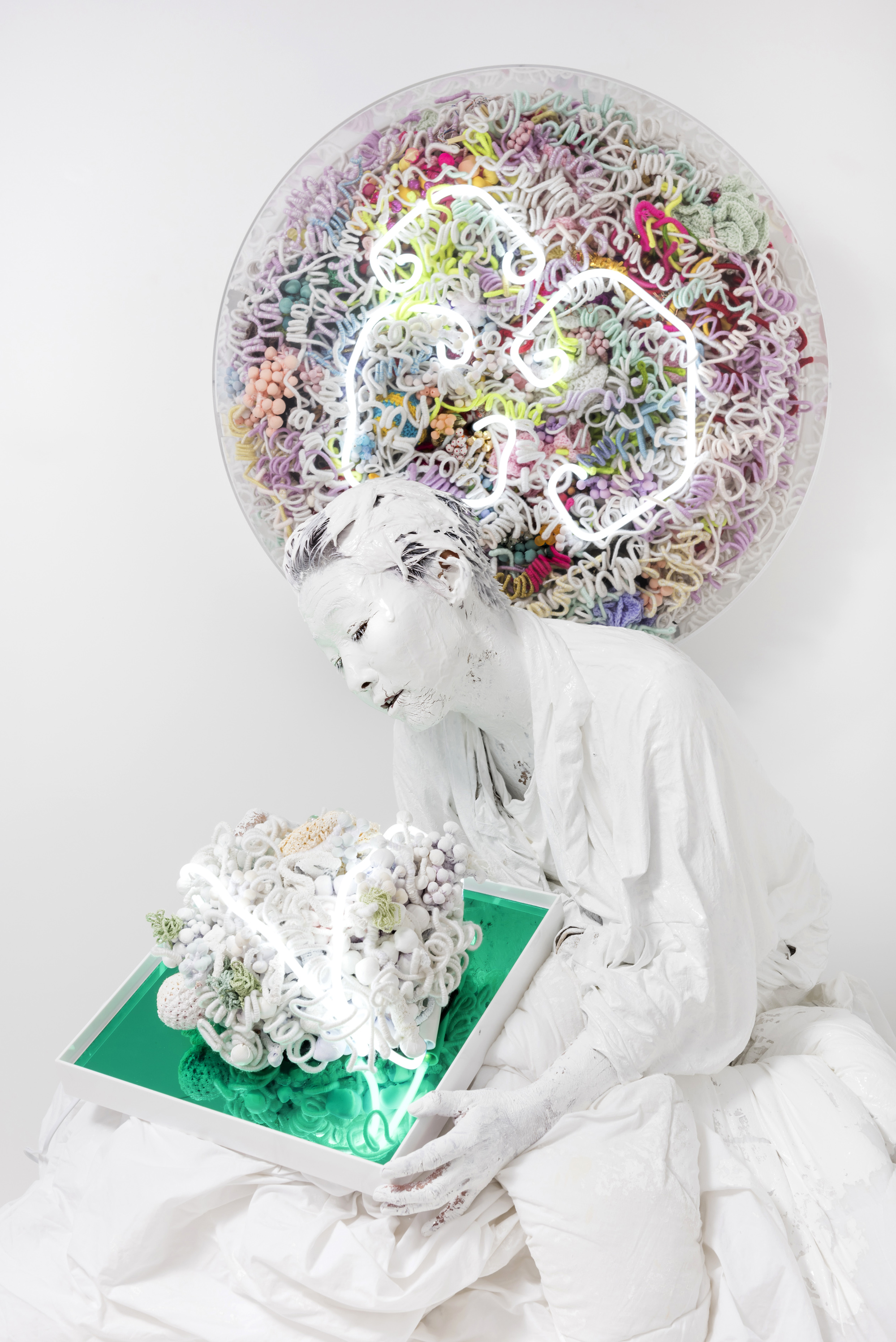
CB: Your work expresses a deep tenderness, compassion and love. Japanese culture has a strong emphasis on nature and the seasons as part of daily life. In these works you imaginatively bring forward these aspects of your own heritage as you embrace these bleached chromosomes. Are you hinting at something here, a way that these difficulties can be healed, through acceptance, love and tenderness?
HT: My earliest memories are of my grandmother, who was tremendously influential in my life. She always wore a kimono and I remember her carrying a parasol – such a traditional lady, with a deep love for nature and gardening. As I consider the power of nurturing, I always return to memories of her and how she cared for me and fostered my love of aesthetics through things like calligraphy and textiles.
I have now been in Australia for half of my life — the other half of course was in Japan. It seems after many years of trying to fit in here, I often long for some aspects of Japanese thinking, behaviour, and culture. I long for silence and understatement. The titles and reflected colours in Bleached Genes reference flowers and plants of the changing seasons, that are charged with poetic and literary references from Japanese classics such as The Tale of Genji (Genji Monogatari).
There are many layers to the work for me. Perhaps Bleached Genes is not so much about a break from the past, but the opportunity to declutter, or to engage with my subconscious and rediscover some unawakened aspects of who I am.
CB: You mentioned different colours for these new works. Does each colour have a specific meaning?
HT: In the Bleached Genes works there is the purple work, inspired by Fuji, a Japanese flower, similar to the Jacaranda in Australia, but they have really incredible draping flowers. I grew up with seeing lots and lots of flowers like that. I call it, “Uncover my soul”.
Orange is for mandarins and the city where I came from originally is famous for mandarin oranges. I am very fond of mandarins for their texture. It’s like squeezing baby flesh. It’s much softer than an orange. I call this one, “Open my vulnerability”
Magenta, is the Cherry blossom, Sakura, “Hold me to be Free” and the Green one is moss, “Endless Silent Tears”.
“Full Moon” is inspired by my close friend who has Trisomy 21 or Down syndrome, a condition characterised by having three copies of the 21st chromosome, rather than two.
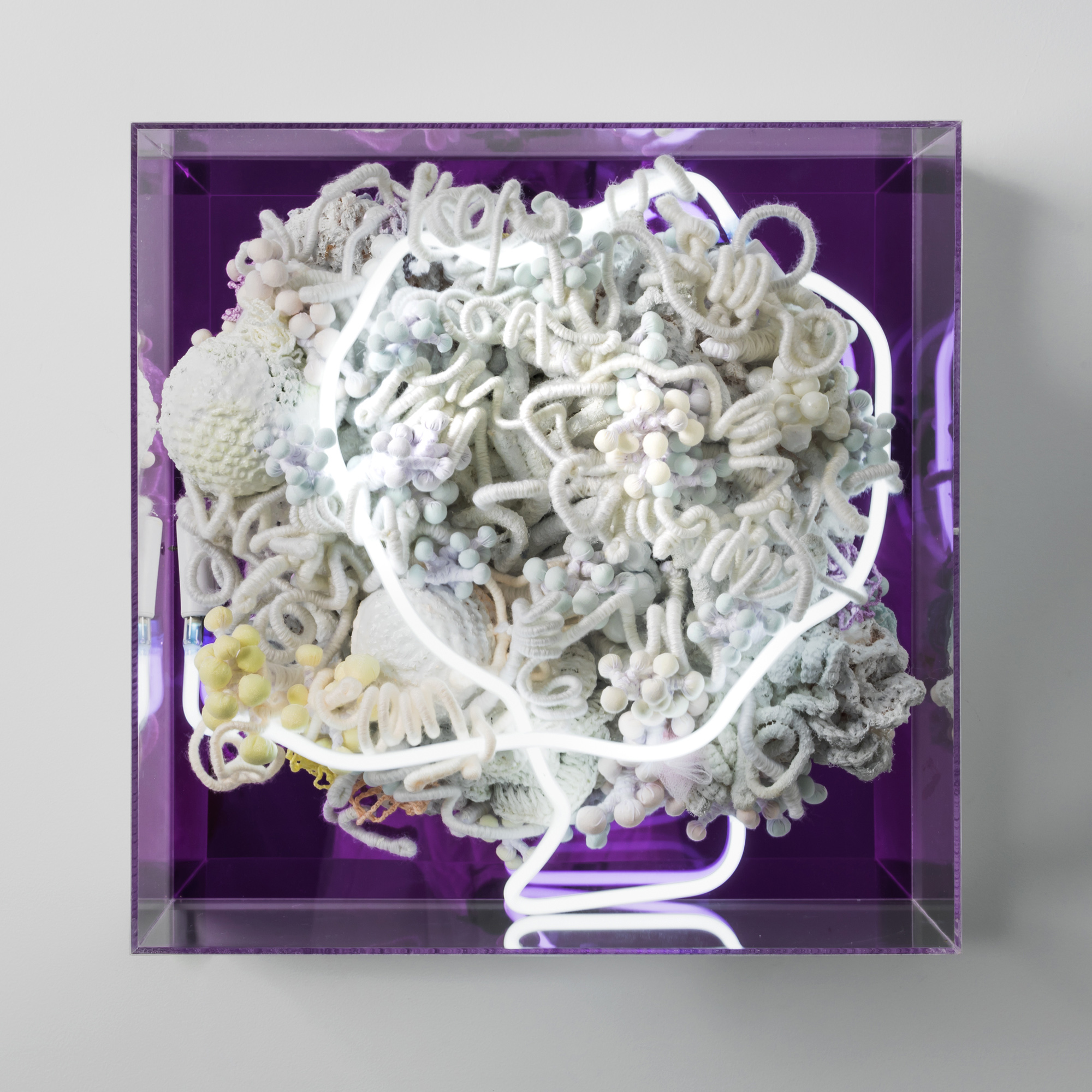
CB: “When Miracles and Magic are woven carefully, we will be healed.” Such an enigmatic statement for you to make. To me this feels like a “raison d’être”? What’s your experience as a weaver of magic and miracles?
HT: This is the quote that I provided for Lisa Slade, the curator for 2016 Adelaide Biennial of Australian Art: Magic Object exhibition, for my Lizard Tail artwork. I carefully thought about it, and thought about the Magic and Miracles – the invisible gap between Art and Science perspectives, and I hoped that when Art and Science collaborate equally and openly, it would be the beginning of the healing process.
In 2014, when I was developing the program Neuro Miracle with more collaboration with scientists and health professionals as an extension of the Art Magic program I had developed over the years, an art colleague kindly advised me that, “ The word “magic” has been devalued to the point of being meaningless in the English-speaking world, beyond the realm of entertainment. And I say that because I deal with scientists and medical researchers on a regular basis. A term that the late art historian Kirk Varnedoe coined in discussing modern art was “a secular miracle” for that which cannot be explained — that thing that is triggered in the brain of an individual. The computer scientist Vannevar Bush used a similar “miracle” inflection in his 1945 essay How We May Think:
“The human mind …operates by association. With one item in its grasp, it snaps instantly to the next that is suggested by the association of thoughts in accordance with some intricate web of trails carried by the cells of the brain. It has other characteristics, of course; trails that are not frequently followed are prone to fade, items are not fully permanent, memory is transitory. Yet the speed of action, the intricacy of trails, the detail of mental pictures, is awe-inspiring beyond all else in nature.”
This feedback on the use of the terms “Miracles” and “Magic” really made me think, and motivated me to focus on weaving those gaps through my art practice.
CB: During the Melbourne Biennale Lab you were creating works and doing performance/ rituals in a market, The Queen Victoria market. Is that correct? What was that like, in an environment and with an audience that were there most likely for purposes other than art, along with those who might have especially made the effort to participate?
HT: I enjoyed the challenge of engaging with the Market, to see it as a brain circuit and create art based on this perspective. My work has often taken place in public spaces, such as shopping malls and shopfront windows, where I used art to create spaces for interpersonal engagement, unexpected connections and sharing stories. I love the fact that anything can happen and that there is a chance to cross paths with someone who may have an experience through art that would not otherwise happen. The Markets provided a rich environment for sensory engagement and to encourage people to become aware of the many opportunities around them to nourish body, soul, and spirit. If art only happens in spaces where people specifically seek to engage, then we are missing so many opportunities to build audiences and create unique experiences as artists.

CB: Chromosomes. How did you get started on this theme with your work? I recently had my own DNA and genetic profile done. It can certainly show up some potential characteristics which are daunting, from a predisposition to Autism or Dementia or as we know now, evidence of epigenetic trauma.
HT: I have been interested for some time in how arts engagement can positively impact our well-being, and the potential for art-making processes to promote healing. Initially my interest was driven by my own personal experiences, and understanding why making art seemed to help me keep a sense of equilibrium. Several years ago, I began to do a lot of reading around neuroplasticity and how our brains can adapt based on experiences. This was truly fascinating for me and made me wonder whether I could, through developing a deeper understanding of how our brains change through experiences, use nurturing through art to overcome characteristics that I was born with, such as anxiety. The theme of chromosomes really started with thinking about nature vs nurture, and a desire to change things that I struggle with.
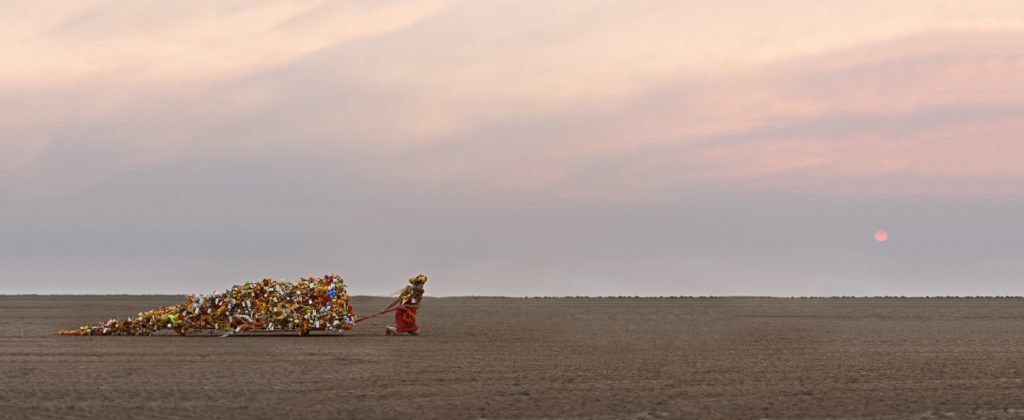
CB: Until fairly recently it was thought that the adult brain couldn’t adapt, that it was “hardwired”. Now we know that it is possible to rewire and change our brains. I feel so much hope is born through this capacity for change. Your work Lizard Tail really explores this concept neuroplasticity, of being able to “drop off” and regenerate.
HT: Lizard Tail is very much part of my ongoing interest in neuroplasticity and epigenetics – the ability to transform and regenerate is exemplified by the lizard’s unique ability to drop and regrow its tail. Over the last seven years I have used nature as a metaphor for brain processes, in works such as Lizard Tail and Sea Tears.
Lizard Tail in particular explored the idea of needing to dissociate from traumatic memories, events, and feelings. Yet it is through traumatic experiences that we develop deep empathy, so my focus shifted from breaking free from trauma to transforming it.
“… it is through traumatic experiences that we develop deep empathy, so my focus shifted from breaking free from trauma to transforming it.”
CB: Your practice has become increasingly focused on exploring these neuro-scientific concepts in your quest to effect healing and well-being. How has your own art healed you?
HT: It remains an ongoing journey. I want to believe, but things are never quite as simple as they sound in theory. Absolutely, making art is as essential to me as eating and sleeping. The meditative aspects of making things, the hope that being able to ask ‘what if’ can engender, the opportunity to reframe something in a more positive way through using art to reimagine an idea, memory, or feeling, the celebratory ritual performances that bring people together… these are all ways that I have seen and experienced art effecting healing. But can we truly change our nature through all of this positive thinking and meditative activity? That remains to be seen…
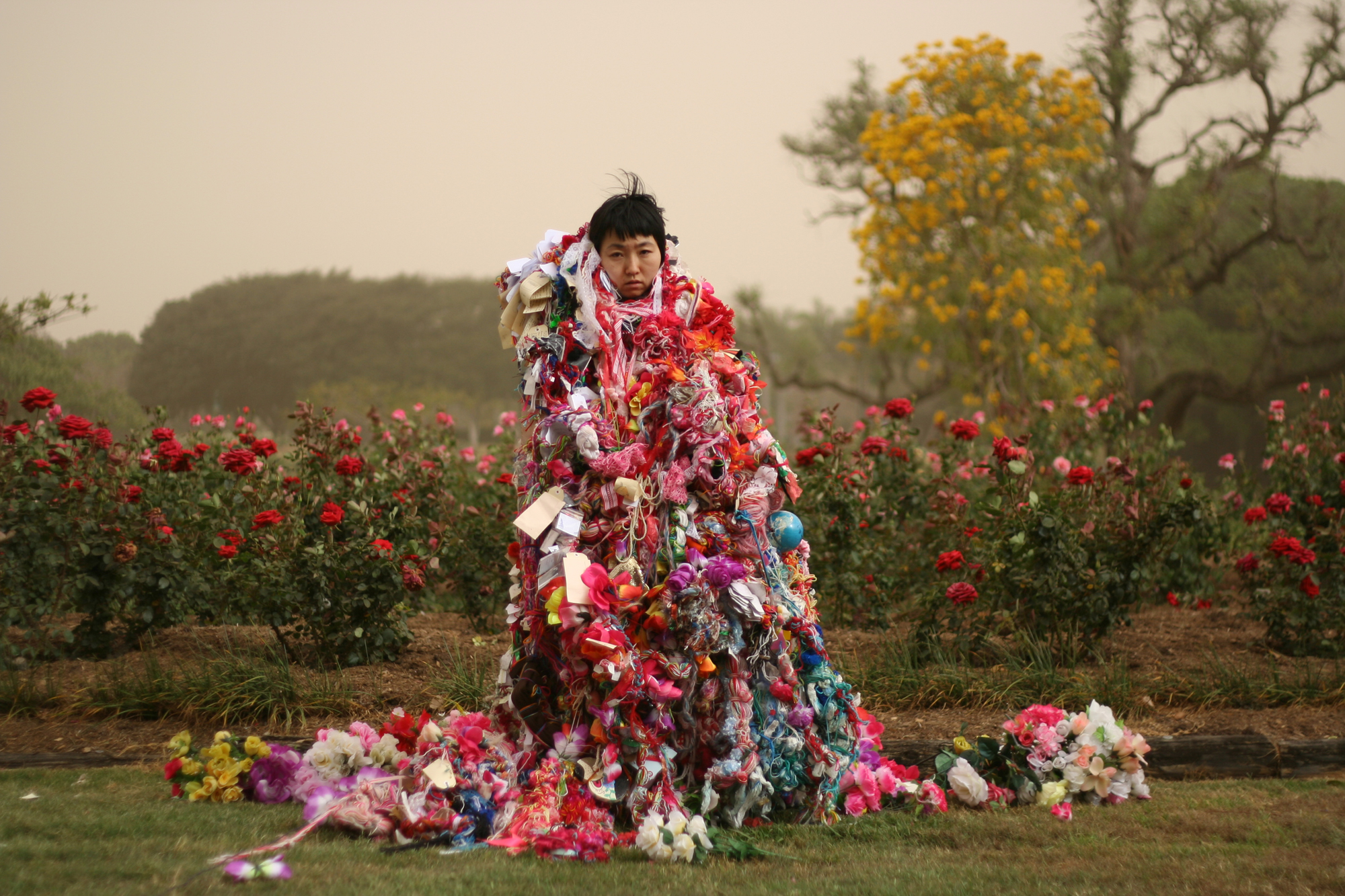
CB: You created Insanity Magnet out of a dust storm, tapping the energy of the storm and your own anger… What do you think about the idea that nature offers us electromagnetic energy which we can harness creatively, such as the emotion and work you gave rise to in that moment? Perhaps nature offers a shift in perception?
HT: For me, Insanity Magnet was about embracing and accepting troubling and uncomfortable feelings and acknowledging them. Often we feel pressured to achieve serenity and to not admit to feeling anger or deep sadness. The energy of the storm swirling around me, stirring up so much dust, gave space for those feelings to come out, to see the light of day, and to demand to be properly acknowledged. You could read it as being a form of catharsis, or perhaps a cautionary tale about what happens when you try to suppress uncomfortable thoughts and feelings, that can create a massive storm once unleashed.
“The energy of the storm swirling around me, stirring up so much dust, gave space for those feelings to come out, to see the light of day, and to demand to be properly acknowledged.”
CB: How do you feel discussing mental health, trauma and conditions such as dementia though your work changes the conversation for people about these issues and their experience of them?
HT: In spite of so much education around mental health, trauma, disability, and dementia, there is still a lot of fear about talking openly about these issues. My hope is that art provides a safe space for these conversations to take place, and to break down the fear that seems to keep people from talking more honestly about their experiences. It always amazes me how many people I speak with have had direct experiences with dementia, disability, or mental illness, and how much many people feel an intense need to share these experiences even though they have been afraid to talk about them. I hope that by using art to gently open these conversations, it can help to lighten the burden that so many carry, and help more people to realise that they are not alone.
“Human relationships are the primary focus of my art. It may sound like an obtuse statement, but for me, how we relate and engage with one another is absolutely an immediate concern.”
CB: You have worked with many communities, including mining communities in WA around mental health. What is it about the collaborative process that surprises you and fascinates you?
HT: The fascinating thing about community engaged practice is the process of learning about a community and coming to understand a little about their strengths and challenges, to create an art experience that will be meaningful and relevant. In spite of how much we have in common, each community is unique and fascinating.
Maintaining boundaries between my own experiences and those of the community members I engage with is essential. I aim to open up dialogue through openly talking with participants about issues I have faced, but always emphasise the importance of working with health professionals. At the end of the day, I am not a counsellor, nor am I a social worker or health professional. Nor do I want to be. I want to be more of a friend, or perhaps a big sister, or mother figure to younger children.
Still, you end up carrying something with you from every community engagement. I have been amazed by the strength of the people I have met who have endured so much over the years. I have been moved by the hope and resilience that children so often show, even in difficult circumstances. I am constantly reminded of how much we share in terms of human experiences, no matter where we are from.
Human relationships are the primary focus of my art. It may sound like an obtuse statement, but for me, how we relate and engage with one another is absolutely an immediate concern.

CB: What are some of you most satisfying moments or milestones so far in your career as an artist? Some of the most challenging aspects? And what is something you hope to yet achieve in your career?
HT: It was a great honour to receive the Sidney Myer Creative Fellowship this year, especially as it enables me to focus on artistic pursuits that are very important to me and served as confirmation that the direction I have been heading in is valued by others in the field. It can be quite challenging to balance the demands of projects that require frequent travel with raising two young children, but my partner and I do our best to ensure consistency for our children while also allowing each other the professional space to pursue our artistic careers. The greatest achievement will be when I feel like I am able to give enough time both to my children, my partner, and to focussing on art and taking great care of myself – self nurture. I am turning 42 this year and I would like to demonstrate to my daughters that it all starts from self nurture. For women particularly this concept needs to be spread and emphasized. I would like young women to grow confidently and healthy to engage with their own sparks instead of trying to fit the “beauty” sometimes expected by the society.
CB: How do you work? Who are some of your influences?
HT: When I have an urge, I respond and create. I try to stay away from the external noise such as trends, categories and politics. Rather, I am focused on maximising my environment and my senses to become fully open and free. I believe that expressing freely and honestly is the artist’s job.
My art making process is simple. I secure the space and energy that allows us to go deeper, engage gently and quietly with memory, emotion, subconsciousness, or the complex pains of the past, present, and future. Sometimes, talking is limiting, but art is limitless. I engage with the art to explore the potentials for us to heal.
I have many influences – but for my art, my personal environment is the major influence of my work, including myself, my family and friends. Their challenges, concerns, health and the complex relationship matters are the inspiration for my work. Research on humanity has been an integral part of my work and my beliefs. People who dedicate their life in a seemingly effortlessly pursuit of humanity moves and inspires me. I would like to dedicate my life more and more to humanity, as our own children grow, and have more time for myself. My children are the strongest influence in my life. I would like to build a healthy and trusting relationship with them. When we spend lot of time together and quality time, it is like a strong warm beam glows in me and gives me incredible strength. And children in general, I get so excited to spend time with them. They are full of potential and I get excited to imagine how they will grow and what kind of unique individuals they will become.
“ My art making process is simple. I secure the space and energy that allows us to go deeper, engage gently and quietly with memory, emotion, subconsciousness, or the complex pains of the past, present, and future. Sometimes, talking is limiting, but art is limitless. I engage with art to explore the potentials for us to heal. “
CB: What are your concerns for the impact of our dependence on technology versus real human connections? Do you feel a responsibility for future generations and for our genetic legacy?
HT: Absolutely. I worry constantly about our over-dependence on technology, how constant connectivity has undermined our human connections and what we are missing developmentally because our engagement is with devices instead of interaction with one another and experiencing the world around us. There was a study done overseas that correlated access to parks and playgrounds with early childhood development. It found that children who lived in areas where they did not have ready access to opportunities to get outside and play were falling behind in reaching key developmental milestones in the first five years of life. If that can happen when we stop climbing and running, imagine what we are doing to ourselves through letting technology take over our face to face interaction as well? For example, think about how much babies learn by watching their caregivers’ faces. Imagine what we are robbing our children of in terms of essential development if we are looking at our phones instead. Healing Chromosomes seeks to wind back this trend and reconnect us on a human level.
“As an artist, I would like to keep imagining though …. like the way I always believed in magic …. I imagine that we can bleach our genes and take away all of the memory, trauma, bad relationships etc., and have a fresh start.”
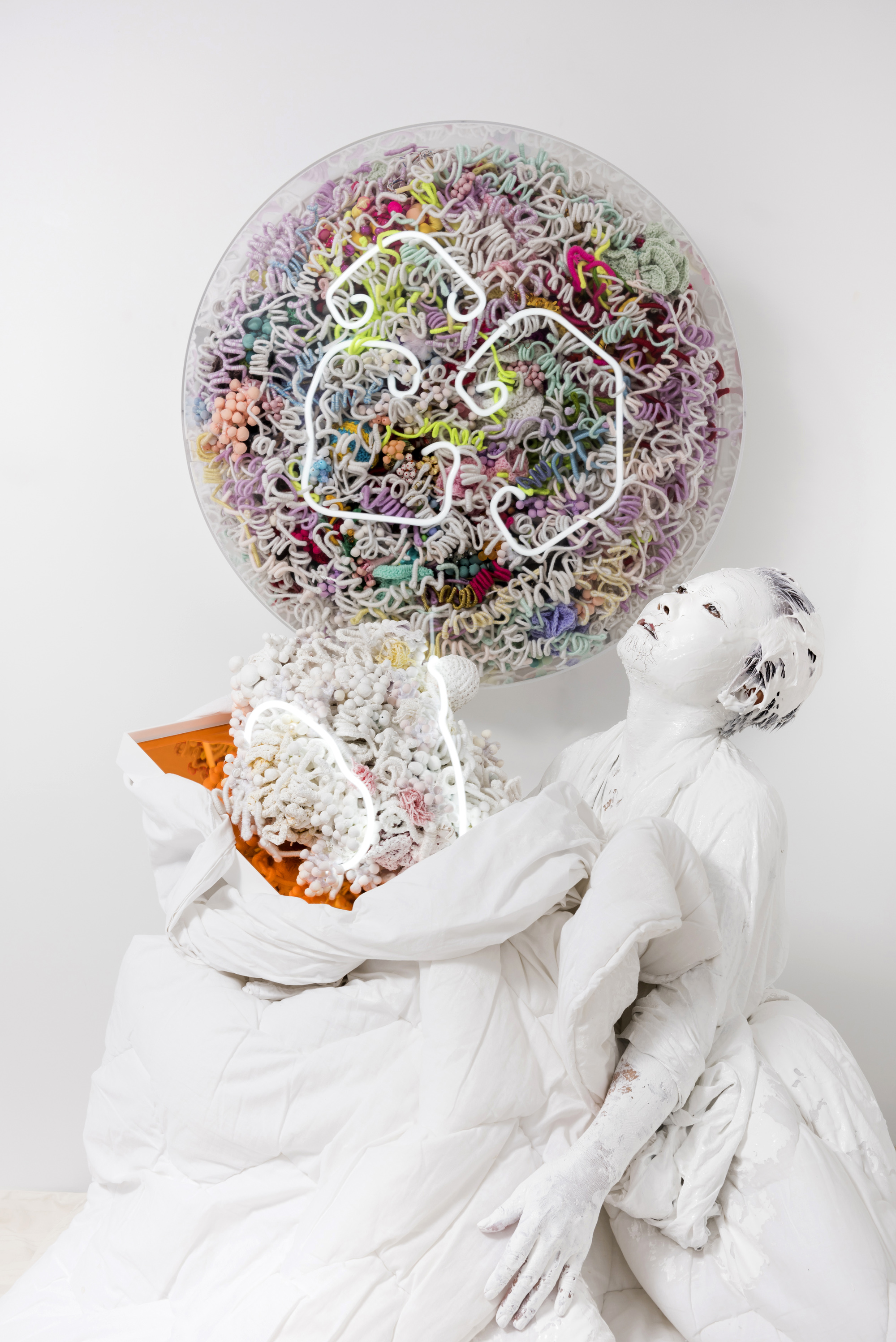
CB: Knowing that this over-dependence on electronic devices is doing us harm, can we counteract the negative impact by doing things differently?
HT: : I sense that no one has time to listen to each other deeply. There is an information overload, and we are expected to engage with one another in brief sound bytes. I question this way of relating. High productivity and efficiency seems to be greatly valued. But if we focus too much on productivity and efficiency, we are losing something very important in our lives. For instance, how do we teach children empathy, if you don’t even have time to listen to your children and ask how they are feeling. How can you teach your children to build healthy and nurturing relationships, if you are looking at screen constantly and multi-tasking, and not even looking at their eyes. This is my dedication to secure quality time with my children, partner, and friends to start with, and use digital devices as an additional component, not to control my life. I turn my phone to aeroplane mode before going to bed or when I am having a dinner with my family. I also ask my partner to do the same and the quality of our time has improved. Even 15 minutes of quality of time with family, without phones or external disruption – allows you to learn so much about one another. I am interested in building meaningful and intimate relationships, in being present and mindful.
The key message with Healing Chromosomes is to disentangle ourselves from the web of devices that have come to dominate our lives, and reconnect with each other as human beings. Re-engaging all of our senses in different ways.
Social media engagement is another area of concern. For example, last year I was advised to establish a presence on Instagram. However, I found it very hard to manage the time to build relationships with Instagram friends as well as my real life relationships. In the end I just became stressed as I was behind on everything. So I took a break and gradually my stress levels decreased and I started to regain my vitality.
Now, I limit my engagement with social media, only opening it when I want to express something important for me to share. Actually, by setting clear boundaries with social media, it has also changed the way I engage with emails, texts, phone calls, or meetings. Instead of responding automatically and constantly, I prioritise the things that I am focused on and engaging with – whether my art, personal life, or work commitments. Here again, it is part of the self nurture, self care process. I try to set a boundary around what I am capable of realistically accomplishing within the day and work from there. Of course at times I should sleep more, but before an exhibition opening, I work 15 hours to 20 hours a day. At these times, it is even more important to sleep and rest when you can …at these times, I may not have time anything else but art. I am learning to accept that this is who I am and fortunately my family and friends are incredibly patient.
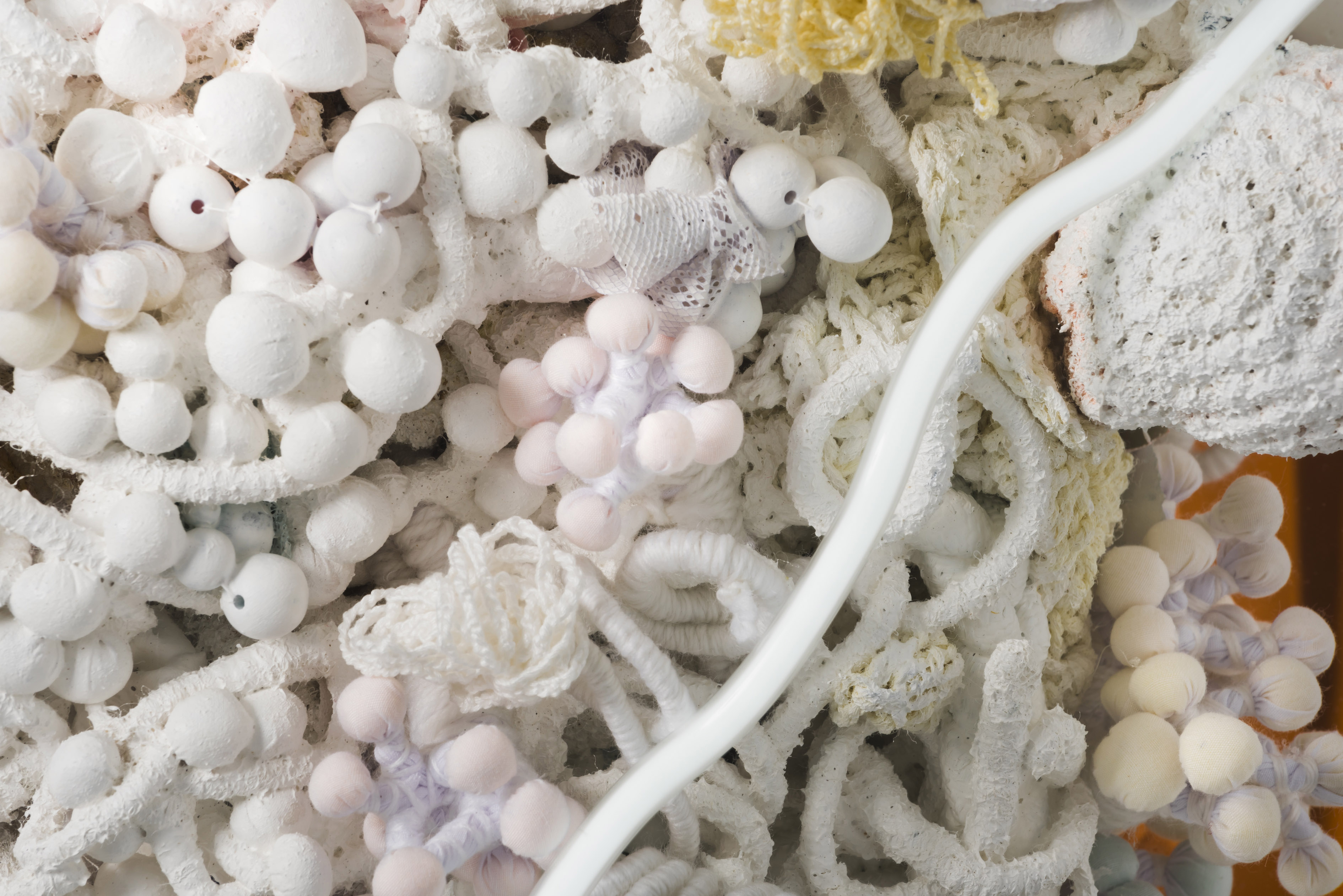
CB: Bleached Genes speaks to erasure, a desire to eliminate the effects of your genes, of what is inherited and a legacy beyond your control. Some things are genetically coded, such as a predisposition to Alzheimer’s, and we know too about epigenetic trauma, passed on to future generations and the susceptibility to PTSD, depression and suicide, which recent research has shown can have a genetic determining component. It is understandable to want to delete and erase the impact of these kinds of genes. Some would consider erasure a destructive act, but I sense something else at work here. Are you wanting to erase the past … or the effects and the legacy as it carries forward?
HT: My artwork is inspired by scientific information, but that serves as a departure point for a poetic journey. I love reading Science Journals, and particularly I subscribe to New Scientist, which I enjoy reading on a regular basis. I find it very fascinating to understand the universe inside our bodies, and imagine – even bacteria – look incredible.
Getting back to the epigenetics and the nature/nurture relationship, this concept has been a recurrent theme in my work, and certainly Bleached Genes asks whether it might be possible to start over again with a clean slate. I imagined all of the inside of the body getting completely cleaned and bleached, right down to the genetic structure, yet of course epigenetic information is unavoidable. But even as the works were conceptualised as stark white and their very nature altered through being coated with resin, subtle colours began to infiltrate the works again. Perhaps it is not really possible to erase the effects of what is hard-coded in our DNA, or perhaps the force of nurture is much stronger than I thought…
As an artist, I would like to keep imagining though …. like the way I always believed in magic …. I imagine that we can bleach our genes and take away all of the memory, trauma, bad relationships etc., and have a fresh start. I love the concept of starting from zero.
Part of the longing for zero is a desire for a feeling of freedom — no responsibility attached. We have so much responsibility in life, even as children … I wonder if animals, plants and birds have responsibilities. Through art I want to create a total sense of freedom. Zero.
CHROMOSOMES
HIROMI TANGO
SULLIVAN+STRUMPF SINGAPORE
26 JAN – 18 FEB 2018
Hiromi Tango
www.hiromitango.com
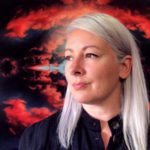
Claire Bridge is a multidisciplinary visual artist and Founder and Editor of Art World Women. Acknowledging gender inequity and to raise the profile of women and non-binary artists, Bridge created Art World Women, artworldwomen.com, the first of its kind in Australia specially focussed on women artists. Her vision is to bring about gender equality through actively and passionately participating in the advancement of women and non-binary artists in Australia and Internationally.
Transformation and the forces of change are key aspects of her own practice. In an ongoing exploration of the relationship between ourselves, each other and our planet, her work connects inner terrains of the human condition with outer terrains of landscape and cosmos, exploring a harmony and dissonance in this relationship.